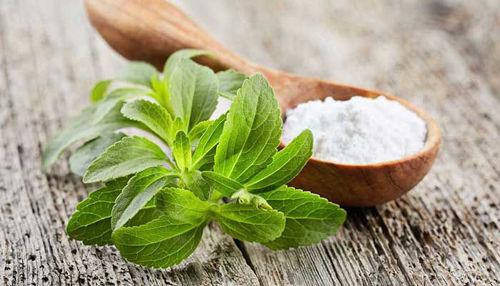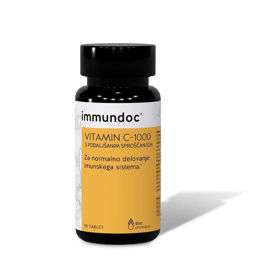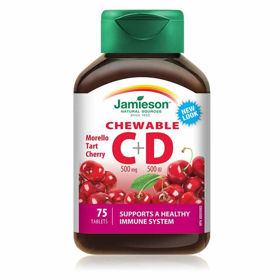Vitamin C, also known as L-ascorbic acid, is a water-soluble vitamin that occurs naturally in some foods and is also available as an ingredient in many nutritional supplements. Unfortunately, humans cannot synthesize vitamin C endogenously, so it is an essential and essential component of the diet.
Vitamin C: Vitamin C, in General, | Vitamin C Types | Shortage | Natural Sources of Vitamin C | Food Supplements | Vitamin C for the immune system | Vitamin C for skin | Recommended daily intake | Risks, interactions and Security | Questions and Answers | Sources/references
Vitamin C is necessary for the biosynthesis of collagen, L-carnitine, and some neurotransmitters. Vitamin C is also involved in protein metabolism. Vitamin C is also an important physiological antioxidant proven to regenerate other antioxidants in the body, including alpha-tocopherol (vitamin E).
In addition to its antioxidant properties, vitamin C plays a vital role in the functioning of the immune system and improves iron absorption. Insufficient vitamin C intake causes scurvy, characterized by fatigue or weakness, widespread weakness of connective tissue, and fragility of capillaries.
Image: The image shows oranges, which are an excellent natural source of vitamin C

The gut cannot absorb vitamin C. Vitamin C absorption is reduced to less than 50% if you take amounts more fabulous than 1000 mg. In healthy adults, large doses of vitamin C are not toxic because absorption decreases when body tissues are saturated with this otherwise essential vitamin, and any excess is excreted in the urine.
However, adverse effects are possible at intakes greater than 3,000 mg per day, including reports of diarrhea, increased kidney stone formation in those with existing kidney disease or a history of stones, increased uric acid levels, and increased iron absorption and overload in individuals with hemochromatosis.
Healthy individuals who eat a lot of fruits and vegetables rarely need vitamin C supplements. However, if you are buying vitamin C supplements, it makes sense to consider several facts and characteristics of the product before purchasing. In addition, it may make sense to reconsider if you want to consume any often unnecessary supplements - for example, binders in nutritional supplements.
Check with your pharmacist to determine if you are deficient in specific vitamins before taking them. You may also want to check if vitamins have any harmful side effects or interact with other medications you may be taking[1].
Different Types of Vitamin C
Ascorbic acid
Ascorbic acid is the most commonly consumed and cheapest vitamin C form. However, the slight acidity of this vitamin can be particularly problematic, especially for people with stomach acid problems. Although ascorbic acid is synthetically produced, it is identical to the formulations in nature. Since only 30 percent of the ingested dose is absorbed, the researchers also looked for other formulations that might be better absorbed in the gastrointestinal tract.
The latter are mineral ascorbates:
- Calcium Ascorbate: This formulation contains both calcium and ascorbate and should be used by those who wish to improve bone health while preventing osteopenia and osteoporosis. One of its advantages is that it causes less stomach irritation compared to ascorbic acid while maintaining the same antioxidant capacity.
- Magnesium ascorbate: this formulation contains both magnesium and ascorbate. This can be an excellent choice for people taking diuretics, proton pump inhibitors, people with chronic headaches, or those with frequent leg cramps.
- Sodium ascorbate: this formulation contains sodium and ascorbate. People on a salt diet should avoid this formulation. The sodium content helps vitamin C to be absorbed more efficiently and stay longer in the body.
Picture: picture shows vitamin C capsules

Fruit, green java contains a lot of vitamin C; enjoy them more often.
Ascorbate and metabolites of vitamin C (Ester-C)
Ascorbate and vitamin C metabolites (Ester-C) are a patented calcium ascorbate formulation discovered in the 1980s. It contains a small amount of vitamin C metabolites, such as calcium threonate, xylonate, lixonate, and dehydroascorbic acid. Ester-C helps improve absorption and causes an increase in vitamin C levels in the blood compared to regular ascorbic acid.
Vitamin C with bioflavonoids
Vitamin C can also be combined with antioxidants known as bioflavonoids. Vitamin C, with bioflavonoids, is 35 percent better absorbed into the bloodstream than the usual formulation of ascorbic acid. Therefore, it is also a better choice for those who may experience stomach discomfort due to ascorbic acid.
Liposomal vitamin C
Video content: video shows the benefits of liposomal vitamin C

Liposomal vitamin C is a formulation that has improved bioavailability or better absorption properties. To increase absorption, scientists have developed liposomal vitamin C, a cell-like structure that helps the ascorbic acid molecule pass quickly through the digestive tract. As a result, oral intake of vitamin C encapsulated in liposomes allows vitamin C concentrations in the blood that are higher compared to concentrations in the case of taking non-encapsulated oral formulations, such as ascorbic acid, but lower in the case of intravenous administration[4].
Vitamin C deficiency
Long-term vitamin C deficiency leads to a disease called scurvy. Scurvy is a disease mainly related to socioeconomic status and access to food. The classic constellation of hair follicles, perifollicular bleeding, and bleeding gums strongly suggest vitamin C deficiency. This medical condition (scurvy) was first reported in 1550 BC when people accurately described the diagnosis.
Hippocrates officially named this condition "ileos ematitis" as "a bad feeling in the mouth; the gums separate from the teeth; blood flows from the nostrils; ulcers on the legs; the skin becomes thinner." In the 17th century, James Lind of the British Royal Navy found that eating lemons and oranges led to disease remission, and in 1927 the structure of ascorbic acid, named vitamin C, was published.
For humans, vitamin C is an essential vitamin, 90% consumed as vegetables and fruits. Therefore, lacking these foods is the most common cause of scurvy. While a small amount is found in leukocytes, adrenal glands, or pituitary glands, a tiny vitamin C is stored in the body. Hence, plasma concentration is mainly related to daily intake. The total supply of vitamin C in the body is 1500 mg, and clinical signs of deficiency appear when this level drops to less than 350 mg.
Vitamin C deficiency is more likely in people who:
- smoke or are exposed to passive smoking
- have gastrointestinal diseases or suffer from a specific type of cancer
- have a limited diet that does not include fruits and vegetables
- have type 1 diabetes
What are the signs of vitamin C deficiency?
Rough, rough skin
Image: The image shows weakened skin on the face, which can be a symptom of vitamin C deficiency

Vitamin C plays a vital role in the production of collagen. When vitamin C levels are low, a skin condition known as keratosis pilaris can develop. In this condition, bumpy skin forms on the back of the upper arms, thighs, or buttocks due to the accumulation of keratin protein in the pores. Keratosis pilaris usually appears after three to five months of insufficient vitamin C intake.
Bright red hair follicles
The hair follicles on the skin's surface contain many tiny blood vessels that supply the area with blood and nutrients. When the body lacks vitamin C, these tiny blood vessels become fragile and break easily, causing small bright red spots around the hair follicles - known as perifollicular bleeding- a well-documented sign of severe vitamin C deficiency.
Spoon-shaped nails with red spots or stripes
A concave shape and frequent breakage characterize spoon nails. They are more commonly associated with iron deficiency anemia and vitamin C deficiency. Red spots or vertical lines in the nail bed, known as splinter hemorrhages, can also occur during vitamin C deficiency due to weakened blood vessels that rupture easily.
Dry skin
Vitamin C keeps the skin healthy by protecting it from oxidative damage and exposure to pollutants. It also stimulates collagen production, making the skin look firm and youthful. High intakes of vitamin C are associated with better skin quality, while lower intakes are associated with a 10% increased risk of developing dry and wrinkled skin. Although dry skin can be a sign of vitamin C deficiency, it can also be caused by many other factors, so this symptom alone is not enough to diagnose.
More frequent occurrence of bruising
Video content: 7 common signs of vitamin C deficiency

Bruises occur when blood vessels under the skin burst, causing blood to leak into the surrounding area. Bruising is a common sign of vitamin C deficiency, as poor collagen production causes weak blood vessels. Bruises associated with vitamin C deficiency can cover large areas of the body or appear as small, purple spots under the skin. Bruising is often one of the first apparent symptoms of vitamin C deficiency.
Slower wound healing
Since the lack of vitamin C slows down collagen production, it causes slower wound healing. In severe cases of vitamin C deficiency, old wounds can reopen, increasing the risk of infection. Slow wound healing is one of the more advanced signs of deficiency and is usually not noticed until a person has been deficient for several months.
Weak bones
Vitamin C deficiency can also affect bone health. Low intake is associated with an increased risk of fractures and osteoporosis. Vitamin C plays a crucial role in bone formation so a deficiency can increase the rate of bone mass loss. A lack of vitamin C can particularly affect a child's skeleton, which is still growing and developing.
Bleeding gums
Red, swollen, and bleeding gums are other common signs of vitamin C deficiency. This is because gum tissue becomes weakened and inflamed without sufficient vitamin C, and blood vessels bleed more easily. In the advanced stages of vitamin C deficiency, the gums can appear purple and rotten. Over time, teeth can fall out due to unhealthy gums and weak dentin, the calcified inner layer of the teeth.
Poor immune system
Vitamin C accumulates in various types of immune cells and helps them fight infections and destroy pathogens that cause diseases. Vitamin C deficiency is associated with poor immunity and a higher risk of infections, including serious illnesses like pneumonia. Many people with scurvy eventually die from an infection caused by a poorly functioning immune system.
Iron deficiency anemia
Vitamin C and iron deficiency anemia often occur together. Signs of iron-deficiency anemia include paleness, fatigue, difficulty breathing during exercise, dry skin and hair, headache, and spoon-shaped nails. Low levels of vitamin C can contribute to iron deficiency anemia by reducing absorption and negatively affecting iron metabolism. Vitamin C deficiency also increases the risk of excessive bleeding.
Fatigue and bad mood
Image: The image shows fatigue, which can be a symptom of vitamin C deficiency

Fatigue and low mood are two of the earliest signs of vitamin C deficiency. However, these symptoms usually appear even before a complete deficiency develops. Although fatigue and irritability may be one of the first symptoms to appear, they usually subside after just a few days of adequate intake or within 24 hours of a high supplement dose.
Chronic inflammation and oxidative stress
Vitamin C is one of the most important antioxidants in the body, which helps prevent cell damage by neutralizing free radicalsfeces. Oxidative stress and inflammation are associated with many chronic diseases, including cardiovascular disease and diabetes. Low vitamin C intake has been linked to higher levels of inflammation and oxidative stress and an increased risk of heart disease.
Where is vitamin C found?
Vitamin C is found in citrus fruits, berries, potatoes, tomatoes, peppers, cabbage, Brussels sprouts, broccoli, and spinach. Choose fruits and vegetables that are in season for superior freshness and nutrients. Frozen fruits and vegetables are also a great option if you live in a climate where seasonal produce is limited.
Citrus
Image: The image shows the natural sources of vitamin C

The amount of vitamin C in citrus fruits depends on many factors, including the fruit's type, size, and ripeness. Just one orange or grapefruit can meet your daily requirement of vitamin C. Here are some estimates of the vitamin C content of common citrus fruits:
- orange: 70-90 mg
- grapefruit: 80-100 mg
- lemon: 30-40 mg
- Lime: 20-30 mg
Crosses
All of the cruciferous vegetables have distinctive cross-shaped flowers – many of them provide you with all or at least most of your daily vitamin C intake. In addition, all of these vegetables are rich in nutrients and antioxidants. Here are some estimates of vitamin C content in common cruciferous vegetables:
- broccoli (1 cup): 80 mg
- Kale (1 cup): 80 mg
- Brussels sprouts (1 cup): 75 mg
- red cabbage (1 cup): 50 mg
- Cauliflower (1 cup): 48 mg
Potato
One medium potato contains about 17 mg of vitamin C or about 35% of your daily intake. It is also an excellent source of potassium and vitamin B6. The key to healthy potatoes is not to fry them in oil or cover them with butter and salt. Instead, potatoes can be boiled, baked, or prepared in a deep fryer with a light coating of olive oil.
Red pepper
Red pepper contains 1.5 times more vitamin C than green pepper. Medium red bell pepper contains over 150% of the recommended vitamin C intake. Bell peppers also contain other antioxidant vitamins, including E and beta-carotene. It also provides abundant polyphenols such as lutein, quercetin, and capsaicin.
Strawberries
One cup of strawberries contains almost 150% of the daily recommended vitamin C intake. They are also an excellent source of dietary fiber, folate, and antioxidants, making them a great addition to your diet. You can prepare strawberries in a smoothie, eat them whole or use them in many healthy desserts.
Papaya
Papaya is a soft, buttery fruit that tastes like mango. One cup of fresh papaya contains almost 90% of your recommended vitamin C intake. It's also rich in dietary fiber, folate, and vitamin A. Fresh papaya can be eaten on its own or added to Greek yogurt.
Guava
Guava has an excess of vitamin C, as one fresh guava contains 73 to 247 mg of this vitamin, depending on the type. Therefore, a guava fruit will provide you with approximately 200% of the daily recommended intake of vitamin C. Like any fruit; guavas can be eaten independently. First, wash the fruit, cut it in half, and scoop out the soft, juicy flesh with a spoon. You can also add it to a fruit salad or smoothie.
Melon
Melon is enriched with vitamins C and A, potassium, and fiber. One cup of cantaloupe will provide about 58% of your recommended amount of vitamin C. Fiber, potassium, and vitamins C and A are essential nutrients for your heart health. Melon is a superfood containing few calories, vitamins, and minerals.
Tomato
Image: The image shows a natural source of vitamin C

A tomato provides you with about 17 mg of vitamin C, although the amount in each tomato depends on its size, type and other factors. This represents about 28% of the daily recommended intake, in addition to other essential nutrients that tomatoes contain, such as potassium, folate, and vitamin K.
Kiwis
With one, you'll get about 117% of the recommended daily amount of vitamin C with kiwifruit. Kiwifruit also boasts other health benefits, including fiber, vitamin E, and potassium - and you'll get even more of those benefits if you eat it with the peel.
Addition of vitamin C with dietary supplements
Vitamin C is best consumed through food or nutritional supplements to meet the needs for this vitamin. Most vitamin C supplements contain vitamin C in ascorbic acid, comparable in bioavailability to vitamin C, which occurs naturally in foods. Therefore, healthy individuals without health problems can meet their vitamin C needs by eating various foods.
Most vitamin C supplements start at 100 to 500 mg per dose, which is higher than the vitamin C content of vitamin C-rich foods. There is a risk of consuming too much vitamin C if your total intake of food and supplements exceeds 2000 mg daily. It is always a good idea to tell your doctor about any supplements you are taking or plan to take, as they may pose unintended health risks for specific groups or interfere with other medications you are taking.
Vitamin C for the immune system
Vitamin C is an essential nutrient that helps build and maintain bones, blood vessels, and skin while strengthening the immune system. Vitamin C contributes to an improved immune defense system by supporting many cellular functions of your body's adaptive immune system. In addition, since it is an antioxidant, it can also fight against free radicals in the body, thereby reducing inflammation and increasing immunity.
The immune system is a multi-layered network of specialized organs, tissues, cells, proteins, and chemicals that has evolved to protect the host against pathogens such as bacteria, viruses, fungi, and parasites. It can be divided into epithelial barriers and cellular and humoral components of innate and acquired immunity. These ingredients interact in several very complex ways.
More than half a century of research has shown that vitamin C is crucial for the functioning of the immune system in many ways, especially in the functioning of immune cells. Vitamin C has many activities that contribute to its immunomodulatory effects. It is a highly effective antioxidant due to its ability to rapidly release electrons, protecting important biomolecules from damage caused by oxidants produced during normal cellular metabolism and exposure to toxins and pollutants.
Vitamin C and skin care
Vitamin C is often taken orally to protect against colds but is also needed to form blood vessels, muscles, and collagen. In addition, vitamin C is said to help improve your skin's health, with many manufacturers of many skin care cosmetics adding vitamin C to their formulations to help prevent dark spots and signs of aging and other skin problems.
Vitamin C for topical use is a scientifically supported and popular ingredient among dermatologists worldwide. Vitamin C is an antioxidant, which means it fights harmful free radicals that come into contact with your skin from external sources like polluted air or from inside your body as a result of normal processes like your metabolism.
Vitamin C can help protect the skin from harmful ultraviolet rays when combined with a broad-spectrum sunscreen. In addition, combining vitamin C with other topical ingredients, namely ferulic acid and vitamin E, reduces redness and helps protect the skin from long-term damage caused by the sun's harmful rays.
In addition, vitamin C can reduce the appearance of dark spots by blocking pigment production in the skin. Topical vitamin C also helps with acne and helps control sebum production in the skin. Different formulations of vitamin C can change its strength and effects on the skin.
Image: The image shows skincare

Consider purchasing vitamin C products from a drugstore or from a verified online retailer with a clinical formulation that contains an active form of vitamin C (such as L-ascorbic acid) at a concentration of 10% to 20% and a pH lower than 3. 5, as this combination has been studied in clinical trials.
Morning skincare routine with vitamin C:
- use a gentle cleanser to clean your skin
- apply a few drops of vitamin C serum to the face, neck, and décolletagethese
- apply moisturizer and sunscreen with a high protection factor
Vitamin C serums are among the most potent skin care products in your collection to address some of the most common skincare concerns, as they contain the highest concentrations of vitamin C. You may experience a slight tingling sensation when using a high % of vitamin C. It may take up to three months of consistent use to see noticeable improvement. If you experience discomfort or irritation, discontinue use[2].
How much vitamin C should we consume per day?
The amount of vitamin C you need daily depends on age and gender. Average daily recommended amounts for different ages are listed below in milligrams (mg). If you smoke, add 35 mg to the values above to calculate the total daily recommended amount.
Daily recommended amounts of vitamin C:
| Lifetime | Recommended daily intake |
| From birth to 6 months | 40 mg |
| Babies 7-12 months | 50 mg |
| Children 1-3 years | 15 mg |
| Children 4-8 years | 25 mg |
| Children aged 9-13 | 45 mg |
| Teenagers 14-18 years old (boys) | 75 mg |
| Teenagers 14-18 years old (girls) | 65 mg |
| Adult (Male) | 90 mg |
| Adults (female) | 75 mg |
| Pregnant women (teenagers) | 80 mg |
| Pregnant women (adult women) | 85 mg |
| Nursing teenage girls | 115 mg |
| Nursing adult women | 120 mg |
Picture: picture shows vitamin C capsules

Excessive consumption of vitamin C can cause diarrhea, nausea, and stomach cramps. In addition, in people with hemochromatosis, which causes the body to store too much iron, high doses of vitamin C can further increase the iron load and subsequently damage the body's tissues.
Daily upper limits of vitamin C:
| Lifetime | Cap |
| Birth to 12 months | Not Found |
| Children 1-3 years | 400 mg |
| Children 4-8 years | 650 mg |
| Children aged 9-13 | 1,200 mg |
| Teens 14-18 | 1800 mg |
| Adults | 2000 mg |
Risks, interactions, and security
Vitamin C supplements may interact with or affect the medications you are taking. Therefore, sharing a list of all supplements and medications you are taking with your doctor is essential. You will find out if unwanted interactions between the medicines you are taking and the nutritional supplements are possible.
Let's list some examples of interactions:
- Food supplements with vitamin C can influence the course of cancer treatment - influence chemotherapy and radiotherapy. Talk to your doctor about taking vitamin C in this situation, especially before taking vitamin C or other antioxidant supplements, especially in high doses.
- Vitamin C and other antioxidants (such as vitamin E, selenium, and beta-carotene) may reduce the protective effects of two drugs (statins and niacin) to control blood cholesterol levels. Therefore, it is essential to regularly monitor lipid levels in people taking statins and antioxidant supplements.
- Taking vitamin C can increase your absorption of aluminum from medications. This can be harmful for people with kidney problems.
- Taking vitamin C in combination with oral contraceptives or hormone replacement therapy can increase estrogen levels.
In some people, oral vitamin C supplements can cause kidney stones, especially in high doses. Long-term use of oral vitamin C supplements in doses of more than 2,000 milligrams per day increases the risk of these side effects.
At your next visit, tell your doctor you are also taking vitamin C supplements. This is because high levels of vitamin C can affect the results of specific tests, such as stool tests, occult blood, or glucose screening tests.
Questions and answers
What are the benefits of vitamin C for the skin?
Picture: picture shows vitamin C serum

Vitamin C has an excellent safety profile; most people can use it topically for long periods without experiencing any side effects. Using vitamin C on your skin has many benefits, such as:
- providing hydration
- skin lightening
- redness reduction
- reduction of hyperpigmentation
- reducing the appearance of dark circles
- promoting collagen production
- prevention of skin aging
- protection against sun damage[1,2].
Can we consume too much vitamin C? What are the consequences?
Although too much vitamin C in the diet is unlikely to be harmful, large doses of vitamin C supplements can cause:
- diarrhea
- nausea
- vomiting
- heartburn
- stomach cramps
- headache[3].
What form of vitamin C is best in a food supplement?
The form of vitamin C depends on your problem, need, and sensitivity. Liposomal vitamin C is better absorbed by the body than regular vitamin C. Liposomes are tiny nano-sized bubbles that mimic the body's cell membranes. Liposomes aid and accelerate absorption by protecting and helping vitamin C travel throughout the body.
This form is excellent for those with digestive issues as it can be absorbed without going through the digestive system[4].
What are the natural sources of vitamin C?
Vitamin C is found in citrus fruits, berries, potatoes, tomatoes, peppers, cabbage, Brussels sprouts, broccoli, and spinach. Choose fruits and vegetables that are in season for superior freshness and nutrients. Frozen fruits and vegetables are also a great option if you live in a climate where seasonal produce is limited[5].
Sources and References
1. Vitamin C - https://www.mayoclinic.org
2. Why is topical vitamin C essential for skin health? - https://www.health.harvard.edu
3. 7 Impressive Ways Vitamin C Benefits Your Body - https://www.healthline.com4. Everything You Need to Know About Liposomal Vitamin C - https://ivboost.uk
5. Vitamin C - https://www.hsph.harvard.edu













